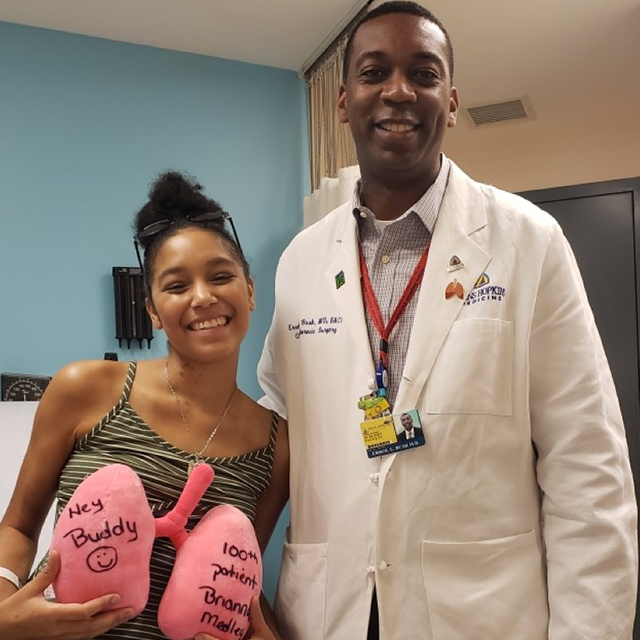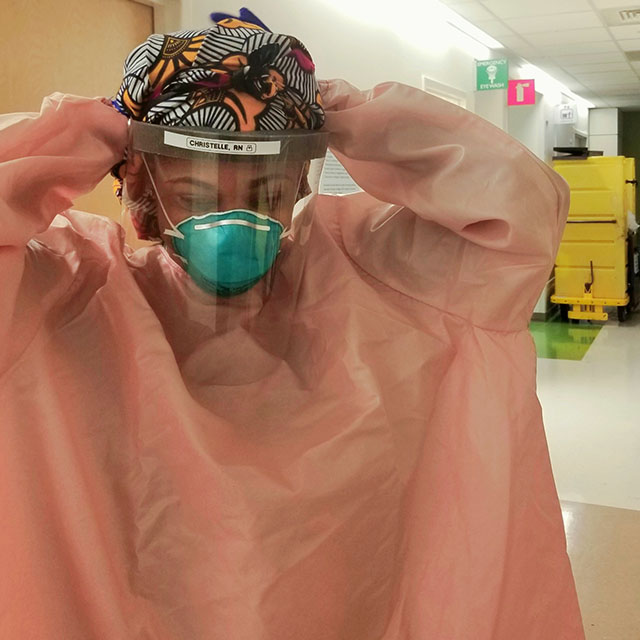Nina Marone was a cardiac nurse for a hospital system near her rural Pennsylvania hometown for several years. She enjoyed the work and liked her colleagues, but was ready for a new challenge.
Last fall, after a few weeks of online exploration, Marone learned about some of the groundbreaking science and medicine happening at The Johns Hopkins Hospital. She also learned that, because of a national shortage of nurses, Johns Hopkins was hiring. On a whim, she spent part of an afternoon on the internet, applying for six nursing positions at the hospital.
“It was kind of a spontaneous thing,” she says with a laugh. “But they all sounded like really great jobs.”
Since the early days of the COVID-19 pandemic in the United States, shifting priorities and workplace burnout have contributed to a nationwide deficit of health care workers. According to the Bureau of Labor Statistics, nearly one in five health care workers has left the medical field since February 2020.
The scarcity is especially severe among nurses. Hospitals across the U.S. report a critical lack of nurses in nearly every specialty. The American Hospital Association projects a shortage of 1.1 million nurses by the end of 2022.
“We’re experiencing the impact across all of our hospitals,” says Kevin W. Sowers, president of the Johns Hopkins Health System and executive vice president of Johns Hopkins Medicine. “Our registered nurse vacancies have increased 50% since last August. It is an extraordinarily challenging time for health care organizations across the country.” (See sidebar)
At The Johns Hopkins Hospital, where roughly 10% of nursing positions are vacant, a group of veteran nurses now spend their days — as well as many evenings — searching for and recruiting nurses in Maryland and across the country.
They scan social media and nursing schools, as well as job-hunting websites and apps, looking for nurses who love learning and teaching and who relish the challenge of caring for the sickest patients.
Recruiter Kayla O’Neil spent seven years as a progressive cardiac care unit (PCCU) nurse and shift coordinator before switching to recruiting. When Marone’s employment applications landed in her email inbox, O’Neil got right to work.
Marone’s phone rang. The call was from Baltimore.
“I thought, ‘That can’t be anyone from Hopkins,’” Marone recalls. “‘I only applied a little while ago.’”
She answered.
“Hello?”
“Hi, Nina! This is Kayla from Johns Hopkins!”
For almost an hour, they talked about nursing and Marone’s career goals while O’Neil gave her a quick snapshot of life at the hospital. The discussion cemented Marone’s interest in Johns Hopkins.
“Kayla was amazing,” Marone says. “She was so patient and so helpful. I never felt any pressure. She just said, ‘Let’s chat. Tell me what you love about being a nurse.’ And then she really listened. That’s when I first started thinking Hopkins is pretty special.”
O’Neil was confident that Marone would make a good Johns Hopkins nurse.
“Nina was enthusiastic and it was obvious that she loves to learn new things,” she says. “That’s a big plus when it comes to selecting the right people for our nurse managers to interview.”
The two kept in touch for a few weeks, with O’Neil answering Marone’s questions and encouraging her. Marone says when the possibility of working at Johns Hopkins began to feel more real, she had some doubts about making the leap.
“It was all a little bit intimidating,” she says. “I wondered if maybe I was getting in over my head. I don’t want to sound dramatic, but honestly, Kayla was like an angel. She listened to [my concerns] and she helped me realize that I really could do the job.”
O’Neil recommended that Marone pursue a job on her old unit, the PCCU, which has been short staffed throughout much of the pandemic. She even arranged for Marone to visit the unit and shadow a nurse for a few hours before interviewing for the job with a nurse manager.
A day or two after the interview, Marone accepted an offer to join the PCCU nursing team. She moved to East Baltimore and, in February, after a six-week orientation to learn the finer points of cardiac nursing, Marone began working on the PCCU’s night shift.
Marone says she is glad that she pursued the position. “The knowledge base at Johns Hopkins is incredible,” she says. “Everybody I work with really values learning. The critical thinking never stops. And there are just so many opportunities to learn new things. Even on ordinary days, I’m learning all the time.”
On the Lookout for Talent
O’Neil is one of six nurse recruiters assigned to attract talented, dedicated nurses to The Johns Hopkins Hospital. Each recruiter looks for nurses in specific practice areas, including medicine, surgery, oncology and perioperative nursing. Within each of those fields are subspecialties, such as neurology and pediatrics. Because of their professional experience, the recruiters are well-positioned to tell their stories about life at a major academic medical center.
The recruiters search for recent nursing school graduates as well as seasoned, more experienced professionals. When they find a nurse who is both qualified and interested in a career at Johns Hopkins, the recruiters cultivate a relationship by answering questions and, when appropriate, providing career advice. Recruiters refer their best candidates to nurse managers on the hospital units for job interviews.
“We let them know that these jobs are challenging, but very rewarding for nurses interested in learning and growing,” says Kelly Alagna, who leads the nurse recruitment team. “We’re looking for the ones who see a tough job and say, ‘That’s what I want to do.’”
Alagna says online job sites like Indeed.com and the social media outlet LinkedIn are good places to mine for nurses interested in a change. The recruiters also turn to Incredible Health, an online service that uses a custom algorithm to connect nurses with specific skills and specialties.
“It’s like a Match.com for nurses,” says Alagna. “It’s been a good source of experienced people who are interested in joining our team.”
The recruiters also host regular Zoom meetings to introduce both new and experienced nurses to Johns Hopkins. Held mostly in the evenings, the meetings are informal and friendly. The recruitment team promotes them on sites like Indeed and LinkedIn — O’Neil says a recent meeting announced on Indeed garnered more than 100 replies from nurses across the country.
During the meetings, the recruiters present information about nursing life at Johns Hopkins. After that, interested attendees enter a virtual waiting room, where recruiters visit them to do quick, gut-level evaluations of whether they might be good candidates.
“We talk to them one-on-one,” says O’Neil. “And if they seem good and they’re interested, we’ll schedule an interview with one of our nurse managers who’s hiring. It’s been a really easy way to just get the whole process started, rather than wait around for them to get back to us.”
The pandemic has meant that most recruitment efforts for the past two years have been virtual. Online job fairs, streamed nursing school graduations, social media and job-search websites have emerged as the go-to recruitment tools.
“Obviously, we’d all rather do this work in person, where it’s much easier to make a connection,” Alagna says. “But the bright side is that we’ve been able to be more efficient, since most of what we’re doing now is by video conferencing.”
During a recent evening session led by Alagna, a few dozen attendees seemed bashful and hesitant to respond to her outreach.
“Let’s talk about some of the reasons you got into nursing,” Alagna says to the group. “Who wants to start?”
After half a minute or so of awkward silence and nervous chuckles from the Zoom crowd, recruiter Melissa Rosenblum speaks up.
“OK, I’ll go first.”
Rosenblum, who joined the recruiter team a month before O’Neil, spent 13 years caring for patients recovering from stroke and other brain injuries. But when COVID-19 hit, a medical condition meant Rosenblum needed to stay away from her job as lead clinical nurse in The Johns Hopkins Hospital’s neuroscience unit.
Answering Alagna’s question, Rosenblum tells the Zoom group about her dedication to patient care. After she could no longer have direct contact with patients, she helped design a new unit that can supply nurses to short-staffed hospital units, a shift at a time.
Rosenblum says the time spent helping to design the supplemental staffing unit gave her a new perspective on nursing at The Johns Hopkins Hospital.
“When I was on the neuro unit, I knew it backward and forward,” she recalls. “But then, working on supplemental staffing gave me the opportunity to see the whole hospital.”
After a few minutes, the group warms to the hosts, who restore momentum any time the discussion shows signs of flagging.
“It’s not hard for me to talk about being a Johns Hopkins nurse,” Alagna says after the online event. “I’ve experienced it. There’s nothing like it. I couldn’t do this recruiting job if I didn’t believe this is literally the best place in the world to be a nurse.”
By the end of the Zoom session, the recruitment team has another handful of nurses interested in making the switch to the Johns Hopkins.



